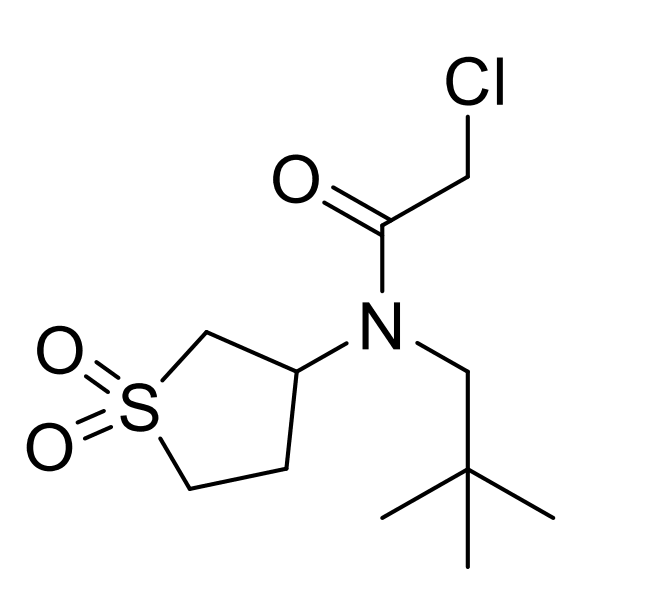| Cas No.: | 2451481-08-4 |
| Chemical Name: | Sulfopin |
| Synonyms: | Sulfopin;Sulfopin;Sulfopin |
| SMILES: | O=C(N(CC(C)(C)C)C(CC1)CS1(=O)=O)CCl |
| Formula: | C11H20ClNO3S |
| M.Wt: | 281.80 |
| Purity: | >97% |
| Sotrage: | 2 years -20°C Powder, 2 weeks 4°C in DMSO, 6 months -80°C in DMSO |
| Publication: | Sulfopin is a covalent inhibitor of Pin1 that blocks Myc-driven tumors in vivo --Nature Chemical Biology (2021) |
| Description: | Sulfopin (PIN1-3) is a highly selective covalent inhibitor of Pin1 with an apparent Ki of 17 nM. Sulfopin blocks Myc-driven tumors in vivo. The peptidyl-prolyl isomerase, Pin1, is exploited in cancer to activate oncogenes and inactivate tumor suppressors[1]. |
| In Vivo: | Sulfopin (40 mg/kg; p.o.; QD/BID for 7 days) regresses neuroblastoma in mice[1]. Sulfopin (20-40 mg/kg; i.p.; daily for 27 days) inhibits pancreatic cancer progression in mice[1]. Sulfopin (25-100 μM) blocks neuroblastoma in zebrafish[1]. Animal Model: Transgenic Th-MYCN mice[1] Dosage: 40 mg/kg Administration: Once a day (QD) or twice a day (BID) for 7 days Result: Sulfopin-treated QD mice showed a significant average increase in survival of 10 days, while Sulfopin-treated BID mice showed an even more pronounced average increase of 28 days. |
| In Vitro: | MDA-MB-468 cells show the most pronounced sensitivity to Sulfopin (1, 2.5 μM; 4-8 days)[1]. Sulfopin (2 μM, HEK293 cells; 48 hours) downregulates Myc transcription[1]. Sulfopin (1, 2.5 μM; PATU-8988T cells; 4 days) shows a small but significant reduction in the number of synthesis (S)-phase cells and a corresponding increase of growth 1 (G1)-phase cells[1]. Cell Proliferation Assay[1] Cell Line: Kuramochi, MDA-MB-468, NGP, NBL-S, MDA-MB-468 cells Concentration: 1, 2.5 μM Incubation Time: 4,6, 8 days Result: Showed variation in antiproliferative effects across cancer cell lines Kuramochi, MDA-MB-468, NGP and NBL-S, with the most pronounced sensitivity observed in MDA-MB-468 cells. |
| References: | [1]. Dubiella C, et al. Sulfopin is a covalent inhibitor of Pin1 that blocks Myc-driven tumors in vivo. Nat Chem Biol. 2021;17(9):954-963. |

 To enhance service speed and avoid tariff delays, we've opened a US warehouse. All US orders ship directly from our US facility.
To enhance service speed and avoid tariff delays, we've opened a US warehouse. All US orders ship directly from our US facility.




















